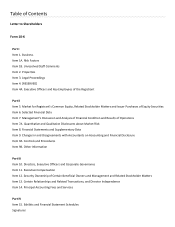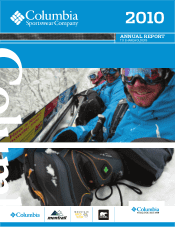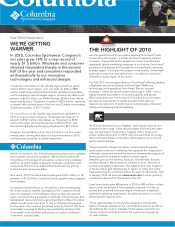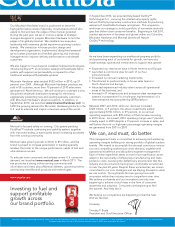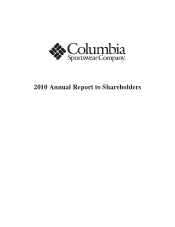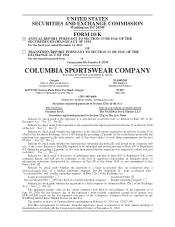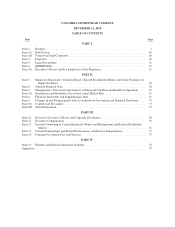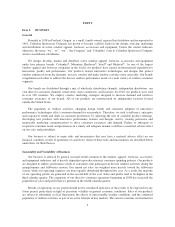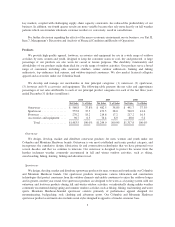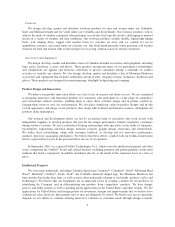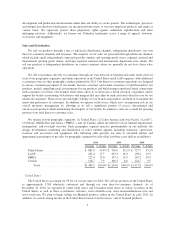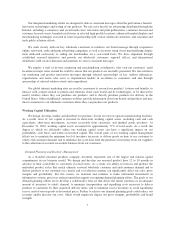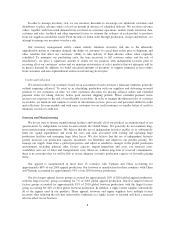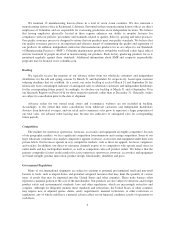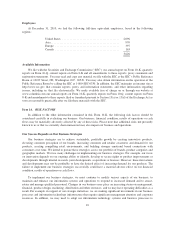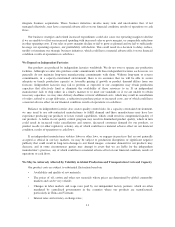Columbia Sportswear 2010 Annual Report Download - page 8
Download and view the complete annual report
Please find page 8 of the 2010 Columbia Sportswear annual report below. You can navigate through the pages in the report by either clicking on the pages listed below, or by using the keyword search tool below to find specific information within the annual report.PART I
Item 1. BUSINESS
General
Founded in 1938 in Portland, Oregon, as a small, family-owned, regional hat distributor and incorporated in
1961, Columbia Sportswear Company has grown to become a global leader in the design, sourcing, marketing
and distribution of active outdoor apparel, footwear, accessories and equipment. Unless the context indicates
otherwise, the terms “we”, “us”, “our”, “the Company” and “Columbia” refer to Columbia Sportswear Company
and its consolidated subsidiaries.
We design, develop, market and distribute active outdoor apparel, footwear, accessories and equipment
under four primary brands: Columbia®, Mountain Hardwear®, Sorel®and Montrail®. As one of the largest
outdoor apparel and footwear companies in the world, our products have earned an international reputation for
innovation, quality and performance. Our products feature innovative technologies and designs that protect
outdoor enthusiasts from the elements, increase comfort and make outdoor activities more enjoyable. Our brands
complement each other to address the diverse outdoor performance needs of a wide variety of outdoor consumer
segments.
Our brands are distributed through a mix of wholesale distribution channels, independent distributors, our
own direct-to-consumer channels (retail stores and e-commerce) and licensees. In 2010, our products were sold
in over 100 countries. We employ creative marketing strategies designed to increase demand and reinforce
consumer awareness of our brands. All of our products are manufactured by independent factories located
outside the United States.
The popularity of outdoor activities, changing design trends and consumer adoption of innovative
performance technologies affect consumer demand for our products. Therefore, we seek to influence, anticipate
and respond to trends and shifts in consumer preferences by adjusting the mix of available product offerings,
developing new products with innovative performance features and designs, and by creating persuasive and
memorable marketing communications to drive consumer awareness and demand. Failure to anticipate or
respond to consumer needs and preferences in a timely and adequate manner could have a material adverse effect
on our sales and profitability.
Our business is subject to many risks and uncertainties that may have a material adverse effect on our
financial condition, results of operations or cash flows. Some of these risks and uncertainties are described below
under Item 1A, Risk Factors.
Seasonality and Variability of Business
Our business is affected by general seasonal trends common to the outdoor, apparel, footwear, accessories
and equipment industries and is heavily dependent upon discretionary consumer spending patterns. Our products
are designed to address performance needs of consumers who participate in diverse outdoor activities during the
spring/summer and fall/winter seasons. Our annual net sales are weighted more heavily toward the fall/winter
season, while our operating expenses are more equally distributed throughout the year. As a result, the majority
of our operating profits are generated in the second half of the year. Sales and profits tend to be highest in the
third calendar quarter. The expansion of our direct-to-consumer operations beginning in 2008 has increased the
proportion of sales and profits that we generate in the fourth calendar quarter.
Results of operations in any period should not be considered indicative of the results to be expected for any
future period, particularly in light of persistent volatility in general economic conditions. Sales of our products
are subject to substantial cyclical fluctuation, the effects of unseasonable weather conditions, and the continued
popularity of outdoor activities as part of an active lifestyle in key markets. The current economic environment in
2

